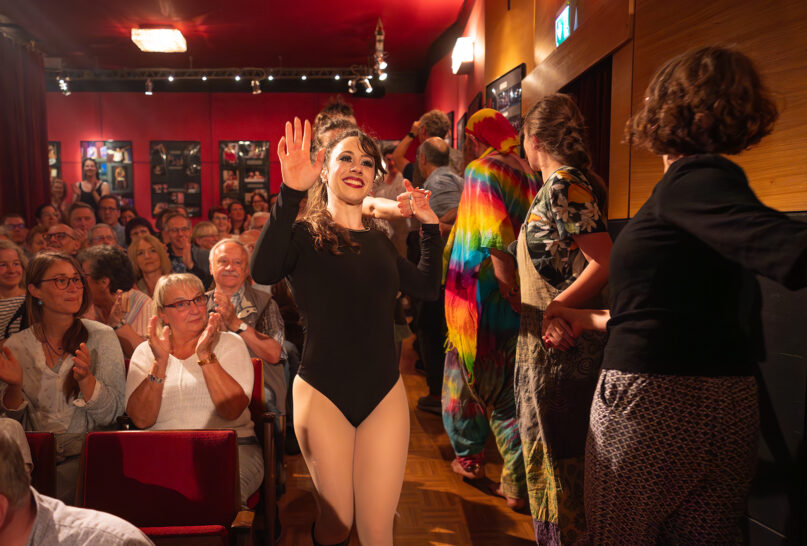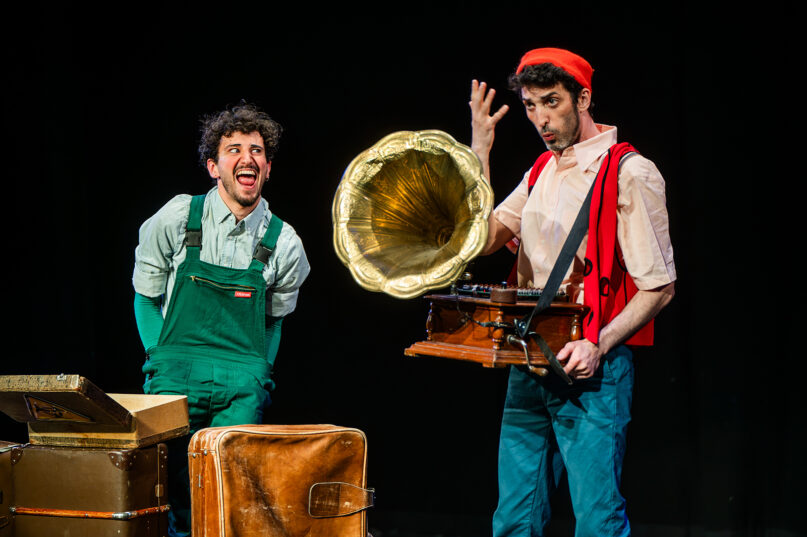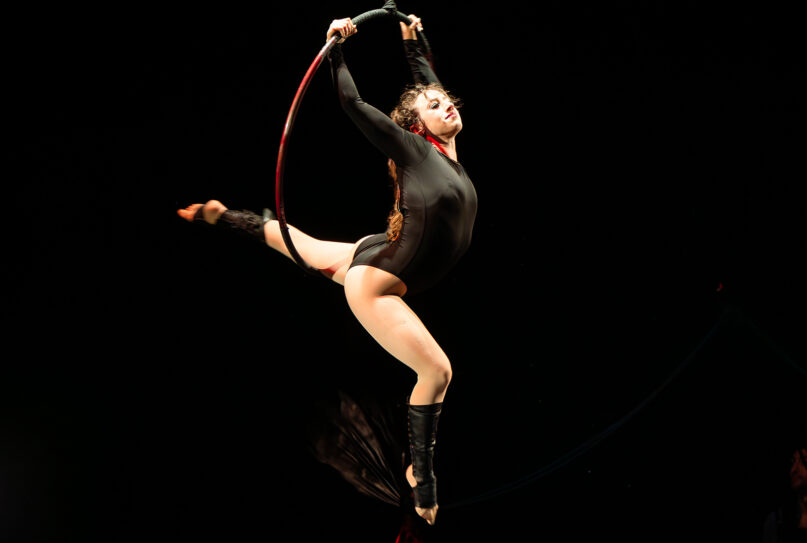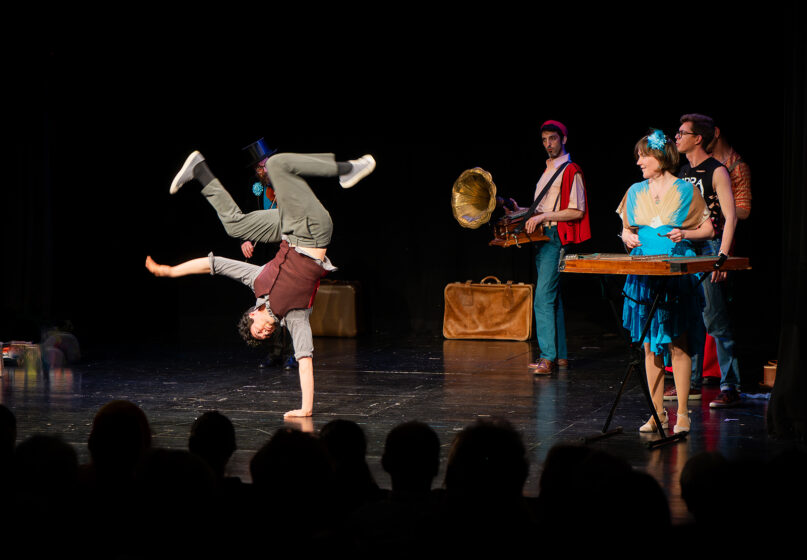(RNS) — From the stage, klezmer circus performer Eliana Pliskin Jacobs reflected on the name of her show, “Tshemodan,” meaning “Suitcase,” which she described as an “object so personal, carrying humanity’s most universal story.”
“Some stories are packed up into suitcases and only unpacked again after a very, very long time,” she said at a June 7 performance.
Tsirk Dobranotch, a musical circus ensemble, is presenting “Tshemodan,” a new collaboration by the Dobranotch band, Pliskin Jacobs and several other circus performers. Their show has been performed in several cities around Germany since May, featuring a medley of aerial acts, acrobatics, juggling and other circus arts, set to a live klezmer soundscape or traditional eastern European Jewish music.
Through the show, the performers also shine a light on the storied history of the Jewish circus, once packed away, now being unpacked again.
Jewish circuses, or troupes run by Jews and starring Jewish performers, had a long tradition, most prominently in Germany but also throughout Europe before the Holocaust. However, they were largely forgotten after World War II.
At the time, circuses were associated with Jews in a way that, for many, Hollywood is today. Stav Meishar, a scholar working on a book about Jewish circus families under Nazi Germany, told RNS it was likely linked to a history of Jews being excluded from many work opportunities in Europe.

Eliana Pliskin Jacobs, center, leads performers through the audience during a “Tshemodan” show. (Photo courtesy of Tsirk Dobranotch)
“For the longest time, Jews couldn’t just hold any job that they wanted,” she said. “There were restrictions — there were just jobs they were allowed to do and not allowed to do. … Show business was one of the only jobs they were allowed to hold because it was perceived as something lowly.”
Among the prominent circus families included the Blumenfelds, whose act began in the 17th century; the Strassburger troupe, known for equestrian arts; and the Lorch family, which toured across the world, including with the Ringling brothers in North America.
Circus performers were “rootless,” Meishar said, traveling around, often at the mercy of weather and road conditions. It wasn’t lucrative, either.
“The wandering Jew stereotype fits very well with the life of a circus artist,” she said. “You’re always on the move. You have everything that you own in the world traveling with you. So, it wasn’t an easy life in any way, shape or form. And circus artists were also historically subject to a lot of suspicion and abuse from the local community.”
Nonetheless, figures like Hungarian clown Zoltán Hirsch, equestrian Arthur Konyot and acrobat Irene Danner awed and astounded audiences until their world was shattered by the Holocaust.

Performers during a “Tshemodan” show. (Photo by Shendy Copitman, courtesy of Tsirk Dobranotch)
Tsirk Dobranotch’s show calls back to that history through acrobatics, juggling, unicycling and musicians performing onstage. It also addresses one of Europe’s major modern issues: the impact of migration, which the group believes Jewish art forms are well-equipped to address.
“The theme of both forced and voluntary migration pervades Jewish history, art and culture, including the arts of Ashkenazi Jews of Eastern Europe,” the group said in a press release. “Famous Yiddish songs and pieces of literature include wandering as a motif for Jewish life.”
It’s also a topic the ensemble is uniquely connected to, Pliskin Jacobs said, as each member has their own migration story. She grew up in the United States and immigrated to Germany as an adult. She’s also the descendant of Holocaust survivors who were forced to flee Europe. The show’s juggler, Bertan Canbeldek, is the child of a Turkish foreign worker who migrated to Germany after the war to rebuild its economy. Turkish Gastarbeiter — guest workers — as the workers were known, became the largest ethnic minority in Germany.
The Dobranotch band is mostly made up of Russians and coalesced in St. Petersburg, but most of its members fled the country after Russia’s invasion of Ukraine, fearing conscription orders. In September 2022, they were in Bulgaria playing a show. After Russia passed its draft law that month, much of the band chose not to return, said Mitia Khramtsov, the band’s lead violinist.
When Pliskin Jacobs approached Khramtsov about the idea of a klezmer circus themed around migration, it seemed like a natural fit.

Aerialist Eliana Pliskin Jacobs performs during a “Tshemodan” show. (Photo by Shendy Copitman, courtesy of Tsirk Dobranotch)
“It was an obvious idea. A traveling circus is kind of a cliche, but here in Germany, though we are established quite well, we still feel like refugees,” Khramtsov said. “It was never my dream to live in Germany. Were it not for the war, I would still be in Russia. So, we are wanderers, too.”
In “Tshemodan,” each performer tells their own story of migration through a series of acts.
Pliskin Jacobs said the show’s writing also covers universalities of migration beyond the Jewish experience.
“I don’t think that there’s a single person who does not have any form of history of migration somewhere in their background,” she said. “I think it’s inherent to our species, our entire planet and the laws of physics.”
While the show calls back to the German-Jewish circuses of yore, past generations’ circus families likely couldn’t have imagined the theme and structure of “Tshemodan,” touching on the difference between classical and contemporary circuses.
“If you think of circus, you think of it as extravagance,” Pliskin Jacobs said of classic productions. “Everything is extremely extravagant, with the biggest and the most money you can pump into a spectacle, like in Cirque du Soleil.”

The Tsirk Dobranotch ensemble performs during the “Tshemodan” show. (Photo by Shendy Copitman, courtesy of Tsirk Dobranotch)
Contemporary circus, she explained, tries to do the opposite, often using few props and relying more on what the human body can do. It also tells a story, which was not commonplace before the 1970s.
“Tshemodan,” she said, takes from both disciplines.
“I do trapeze, dance and aerial hoop,” she said. “That’s my focus and these are traditional circus disciplines. But at the same time, I’m standing on stage and making a speech (about) the Holocaust, and that’s circus, too, because I’m performing it in a circus.”







